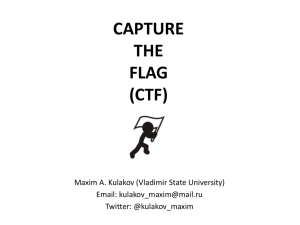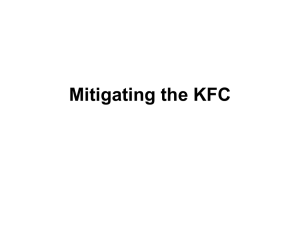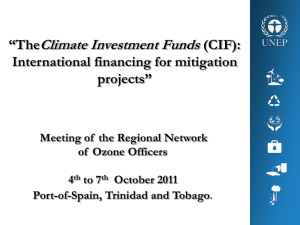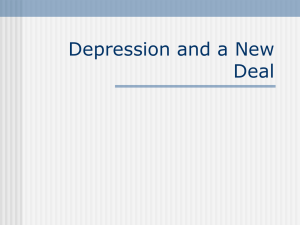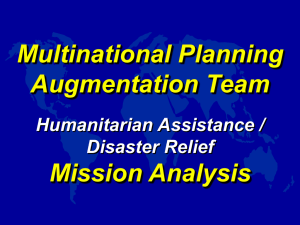HA DR TE 5 Briefing - Short Version (July 03)
advertisement
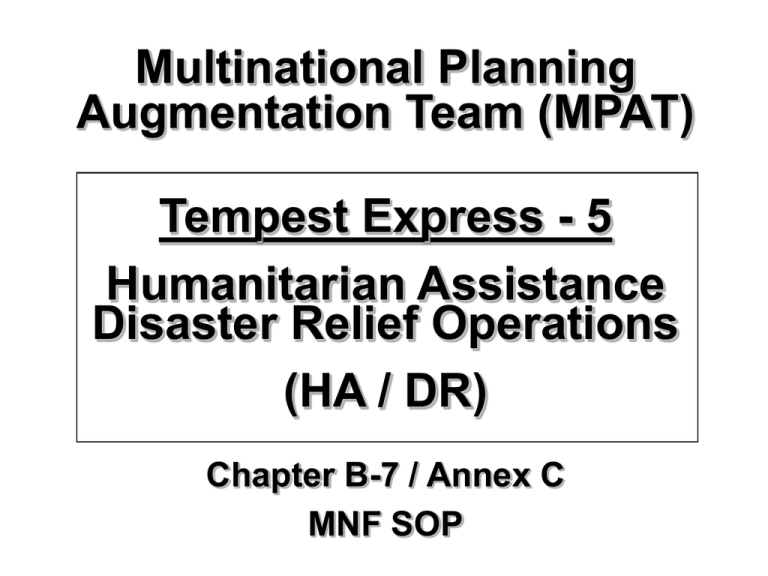
Multinational Planning Augmentation Team (MPAT) Tempest Express - 5 Humanitarian Assistance Disaster Relief Operations (HA / DR) Chapter B-7 / Annex C MNF SOP Agenda • HA / DR Focus • HA / DR Context and Operational Focus • 10 Broad CTF Planning Factors - HA / DR • CTF Headquarters and Command Relationships for HA / DR • Types of Military HA / DR Missions • Unity of Effort and Key HA / DR Organizations • Summary HA / DR • Primary Focus: Conducted to alleviate human suffering • Prime responsibility usually rests with specialized agencies: – – – – – Civil National International Government Non-Government • Military forces are always "in support" HA / DR Operational Context • Unilateral: Nation provides HA / DR without direct involvement by countries other than the affected country – Immediate response essential – Can transition to multinational response • Multinational: Involves military forces and civilian agencies from more than one nation. Can be initiated and controlled by the United Nations, regional organization within an alliance, or a Lead Nation of a coalition effort. • MNF SOP Focus: Lead Nation for a coalition effort (coalition of the willing - multinational operation) HA / DR Operational Environment • Permissive: – Host, or affected country military and law enforcement agencies have control and the intent and capability to assist HA operations. • Uncertain: – Host government forces, whether opposed to or receptive to operations that the CTF intends to conduct, do not have totally effective control of the territory and population within the intended area of operations. • Hostile: – Hostile forces have control and the intent and capability to effectively oppose or react to operations the CTF intends to conduct. The CTF must be prepared to engage a full range of force protection measures. 10 Broad CTF Planning Factors HA / DR CTF Planning Factors #1: Five Basic Military HA / DR Missions – Security – Relief – Dislocated Civilian Support – Technical Assistance – Consequence Management Support • Response to: Chemical, Biological, Radiological, Nuclear, and High yield explosives (CBRNE) incident (Mission details will be covered in later slides) CTF Planning Factors #2: Specialized Civilian Agencies should be the lead for HA / DR - CRITICAL – Military functions should be short-term and impactdriven – Do not create long term military dependency – CTF command should not be in charge of long term development programs – The affected / host nation civil agencies and private corporations are more appropriate for long term actions once stability and security is established CTF Planning Factors #3: Military involvement with HA / DR varies with each country – In some countries, military has primary responsibility and virtually ALL of the resources to execute HA/DR missions – In other countries, military is supporting only and may only get involved in life-threatening situations CTF Planning Factors #4: Key knowledge areas for CTF leaders and planners: – What are the "links and coordinating mechanisms" between the military forces of the affected / host nation and the various relief agencies ? – How does the country's military transition the HA / DR mission back to the government and relief agencies ? CTF Planning Factors #5: CTF operations and cultural, social, economic and political aspects of the affected country – There may be vast differences in culture and sophistication of civic organizations between CTF forces and the affected / host nation – Population "views" on the nature and cause of the disaster may differ from ours – If not properly acknowledged, addressed, and taken into account these differences can work against CTF mission accomplishment CTF Planning Factors #6: Civil Military Operations Center (CMOC) is the CTF’s focal point to coordinate, interface and deconflict CTF forces operations and relief agencies operations – HA / DR requires close and continuous coordination and cooperation with non-CTF organizations – CMOC works closely with the Non-Governmental (NGO) and International Organizations (IO) and the affected countries governmental agencies (military, police, relief organizations, etc.) – CMOC achieve unity of effort with NGO, IO, and affected nation's agencies CTF Planning Factors #7: HA / DR may be part of a much larger CTF. Mission - end states / transition plans must be integrated. – Normally, current day Peace Operations (PO) missions (Peacekeeping and Peace Enforcement) almost always involve some form of HA / DR) – Simultaneous execution of PO and HA / DR missions is called a Complex Contingency / Emergency – HA / DR end states and transition plans must be thoroughly integrated with larger CTF mission • Must also support the affected country and civil relief agencies objectives CTF Planning Factors #8: The "Type of Disaster" and its affect will shape the CTF's structure and response requirements. A clear and focused "estimate of the situation" is required early on (determine the disaster's nature and All factors of the disaster) – Examples: • Volcanic eruptions can quickly isolate communities and can hamper air operations. • Typhoons / floods can cause the spread of communicable diseases • Large scale, deliberately caused man-made disaster will most likely require Consequence Management mission response • HA / DR with PO missions will most likely require some form of combat security operations and well developed Rules of Engagement (ROE) will be required – Bottom Line: CTF planners must identify all factors affecting the disaster CTF Planning Factors #9: Third Country Relationships – Some small countries (in particular island nations within the South Pacific) have paramilitary forces or no military forces at all • Will have treaties in place or other formal agreements with other nations • The details of such treaties and agreements and the responsibilities of other nations are key for CTF planners CTF Planning Factors #10: Critical CTF Planning Documents. As outlined in the Peace Operations Annex, the below documents are key for CTF planners (provides the mission guidance / background on the HA / DR mission). #1: United Nations Security Council Resolution (UNSCR). If UN sponsored or authorized. #2: Peace Agreement #3: Mandate (contained within one of the UNSCR for the mission) #4: Status of Forces / Mission Agreement (SOFA / SOMA) #5: Terms of Reference (TOR) for the specific HA / DR mission #6: Rules of Engagement (ROE) for the operations and Contingency ROE for sequels / branches to CTF mission #7: Memorandums of Understanding (MOUs) for the specific HA / DR mission #8: Consolidated Appeal Process (CAP) and Command Humanitarian Action Plan (CHAP). HA / DR Operational Environment & CTF Focus CTF Planning Factors CTF Headquarters Organization HA / DR & Command Relationships CTF Headquarters Organization - HA / DR Red Area “ Shared Top Level Classification Info Area Commander Coalition / Combined Task Force (CCTF) Classification: Secret – MNF REL DCCTF Personal Staff Coalition Coordination Center (CCC) Special Access Ops (SOF) C1 PERS C2 C3 INTEL OPNS Classification: Case by Case COS C4 C5 C6 LOG C7 PLANS COMMS CIV-MIL CTF PLANNING PROCESS (C5 PLANS, C3 FOPS, and C3 COPS) Civil-Military Operations Center (CMOC) Key Organization Coalition / Combined Logistics Coordination Center (CLCC) Secret – MNF REL Multinational and CTF Media Support Staffs (Coalition / Combined Media Pools) Legend: MNF REL: Multinational Force Releasable Liaison & Coordination HA / DR Operations Command / Control / Coordination (Strategic and Operational Levels) Options: 1. Multinational Lead Nation (Coalition, Non–UN Operation) 2. Multinational Lead Nation – Modified (Coalition, NonUN Operation) 3. Regional Organization Led (Combined, Non-UN Operation) 4. UN Sanctioned/Authorized – Coalition, Lead Nation Led or Combined, Regional Organization Led 5. UN Sponsored/Mandated – UN Led (refer to the PO Briefing or PO Chapter B-7, Annex B for details) CTF Planning Factors Types of Military HA / DR Missions Five Basic Military HA / DR Missions • Security • Relief • Dislocated Civilian Support • Technical Assistance • Consequence Management Support – Response to: Chemical, Biological, Radiological, Nuclear, and High yield explosives (CBRNE) incident Common HA / DR Characteristics • Emergency / Short Term Tasks • Requirement for close military coordination and cooperation with with NGO / IO / Affected nation governmental agencies (CTF CMOC importance) • Primacy (lead) of NGO / IO relief organizations in the disaster area • Termination of military support and Transition of tasks to appropriate authorities / relief agencies as soon as possible (well thought out end states for military and well developed / coordinated transition plans) Security Mission • Establish secure conditions for the world relief community to provide HA / DR – Delivery of humanitarian relief supplies and relief support often depends on having serviceable and secure transportation / communication network • Normally will be unstable in a disaster / crisis • Need for early-on military force assistance is very likely – CTF Potential Tasks: • Security for storage areas • Security and Armed Escorts for convoys and personnel • Protection of dislocated civilian camps • Maintenance of dislocated civilian camp operation in support of UN, NGO / IO and governmental agencies • Other security requirements as the situation requires – End State: Conditions within the country return to a level where the affected nation can provide essential security requirements for HA/DR Relief Mission • Prompt aid that can be used to a alleviate the suffering of disaster victims – Traditional distribution of relief aid is domain of UN, NGO, IO, and governmental agencies (expertise / charter / experience) – Relief community can become overwhelmed or distribution early on may require extensive security requirements in high threat areas (uncertain / hostile) – CTF Potential Tasks: • Immediate response to prevent loss of life and destruction of property • Construction of basic sanitation facilities and distribution of food and medical care • Assist or facilitate in dissemination of relief information • Support cooperation and coordination of relief agency actions – End State: Conditions return to level where traditional relief agencies can distribute aid without military support Dislocated Civilian Support • Military support of dislocated civilians (refugees, displaced persons, migrants, stateless persons, evacuees, internally displaced persons, and evacuees -- see following slides for definitions). – CTF Potential Tasks: • Camp organization, basic construction, and administration; provision of food, supplies, medical attention; basic security concerns; and placement (movement or relocation to other countries, camps, and locations). • The first priority for the management of dislocated civilians should be to use the services and facilities of civilian agencies when coordination can be effected. This allows the CTF to concentrate its resources on other HA/DR support efforts. • Dislocated civilian operations are often long-term and require enormous resources. • The UN, NGO, IO and governmental agencies (with potential support from private corporations are better suited for long-term support of this mission – End State: Conditions reestablished whereby military support is no longer required for dislocated civilian support. Primary or secondary support missions transferred to UN, NGO, IO and/or governmental agencies. Dislocated Civilian Support Definitions: Categories of dislocated civilians are key for international legal implications. – Refugees: Persons who are outside the country of their nationality due to a well-founded fear of being persecuted for reasons of race, religion, nationality, membership of a particular social group, or political opinion and are unable or unwilling to avail him / her of the protection of that country, owning to such fear. – Displaced Persons: Civilian who are involuntarily outside the national boundaries of their country. This may be due to natural or man-made disasters or other reasons not associated with persecution. It is important to understand the difference between refugees and displaced persons because of the associated legal ramifications. – Migrant: Persons who voluntarily leave their country and leave their homes temporarily or permanently for reasons other than those for refugees for taking up residence elsewhere. Migrants who leave exclusively for economic considerations are economic migrants. (continued) Dislocated Civilian Support Definitions Continued: – Stateless Persons: Civilian who either have been denationalized, whose country of origin cannot be determined, or who cannot establish their right to the nationality claimed. – Evacuees: Civilians who are removed from their places of residence by civil of military direction for reasons or personal security of the requirements of the military situation. – Internally Displaced Persons: Civilians who flee their homes as a result of or to avoid the affects of armed conflicts, situations of generalized violence, violations of human rights or man-made disasters, and who have not crossed an internationally recognized State border. – Expelle: Civilian outside the boundaries of the country of his or her nationality or ethnic origin who is being forcibly repatriated to that country or to a third country for political of other purposes. Technical Assistance Mission • Provide short-term technical assistance in areas including, but not limited to communications restoration, relief supply management, medical care, and provision of emergency transportation for persons of risk, high priority relief supply delivery, establishment and training of Search, Rescue, and Recovery Teams, and de-mining. – CTF policies regarding technical advice and assistance to the affected nations and relief organizations must be established early on – Policies must establish what may be provided and the source of authority for the assistance – CTF Potential Tasks: • Advice, selected training, assessments, focused manpower, and equipment • Infrastructure support for limited emergency requirements – End State: Conditions return to a level where technical assistance is no longer required and the affected nation with support from relief organizations can maintain basis infrastructure requirements Consequence Management (CM) Mission • CM operations eliminate the negative impact of: – Intentional or inadvertent release of weapons of mass destruction (chemical, biological, radiological, nuclear materials or high yield explosives (CBRNEs)) – Epidemics (infectious disease, biological) and natural disasters – CTF Potential Tasks: • CM operations involve those essential services and activities required to manage, mitigate, or reduce problems resulting from catastrophic events. • Such services may include reestablishment of emergency infrastructures of security, transportation, communications, public works, fire fighting, information planning, care of mass casualties, resources support, essential or routine health and medical services, urban search and rescue, distribution of food, and energy-related services. • Special mission requirements may be required for disposal of hazardous materials, distribution of food, and energy-related services. – End State: Conditions return to normalcy whereby the local governmental agencies with support from relief agencies can provide the essential services and activities required for operation of the national and local infrastructures. CTF Planning Factors Unity of Effort & Key Organizations for Addressing HA / DR Missions Unity of Effort • Complex Emergencies (combination of HA / DR and PO missions occurring within the same crisis situation) requires the actions of military, diplomatic, local and international humanitarian relief agencies (UN / NGO / IO), and the affected nation's governmental agencies. – This places an priority for "Unity of Effort" for all of these forces and agencies to address the mission requirements for HA / DR – Cooperation, coordination, and teamwork MUST be established early on for efficient and effective relief operations. And this cooperation must be nurtured, maintained, and improved over the life span of the relief mission • Two key organizations in this regard are: – Humanitarian Operations Center (HOC) - Strategic / National level – Civil Military Operations Center (CMOC) - CTF Headquarters level (operational level) HOC (National Level) • Overall Coordinator: Coordinates the overall relief strategy, identifies logistic requirements for UN, NGO, IO, and other governmental support agencies in support of HA / DR relief operations • Strategic / National Level: Normally established under the direction of the affected nation's government (with technical support / advice as required). – Can be established by the UN for UN sponsored operations – Can be established by the Lead Nation for Coalitions of the Willing (Lead Nation / Coalition Based Operations) – Can be a combination of the above with the affected nation's government • Not a Command: Normally will have NO command and control authority; rather, will be a coordination / cooperative consensus organization with senior leadership • Requires Senior Leaders / Legitimacy: Ideally, should be a Cabinet level type structure with senior civilian / UN / NGO - IO officials with some form of military representation. Example: Department /Ministry of Health, Defense, or Emergency Management Office. Legitimacy in the eyes of the NGO / IO is essential • HOC - CMOC Linkage: The CTF command must establish firm cooperation and coordination processes with the HOC using the CMOC organization within the CTF Headquarters organization CMOC (CTF Level) • Overall CTF Coordinator: Coordinates the overall CTF relief mission, with the HOC and the UN, NGO, IO, and other governmental support agencies in support of HA / DR relief operations • Essential CTF Headquarters Organization: Must be an essential part of the CTF Headquarters organization. – Should be the responsibility of the C7 staff directorate and report directly to the Chief of Staff within the CTF Headquarters – Should be senior officer and have appropriate staffing resources for executing the CMOC Coordination / cooperation tasks with the HOC – CMOC organization should be tailored to the mission (template for organization is in the MNF SOP, Chapter C-7) • Seek out and Build Unity of Effort: The CMOC should not expect relief agencies to come to the CMOC. It is very possible that many agencies may have cross purposes with the CTF missions or even have antimilitary sentiments. The CMOC leaders and staff must "seek out and build cooperation" – Must establish firm cooperation and coordination processes with the HOC – Must integrate the perspectives, missions, and requirements of the HOC and UN / NGO / IO and governmental agencies into all CTF mission planning CTF Planning Factors Summary HA / DR Summary • Primary Focus: Conducted to alleviate human suffering • Prime responsibility rests with specialized agencies: – – – – – Civilian National International Government Non-Government (UN, NGO, IO, and affected Governmental Agencies) • Military forces are always "in support", identification of civil-military tasks early on is essential. CTF planning must integrate and support relief agencies • Five Basic Military HA / DR Missions – Security – Relief – Dislocated Civilian Support – Technical Assistance – Consequence Management Support • Response to: Chemical, Biological, Radiological, Nuclear, and High yield explosives (CBRNE) incident • HOC and CMOC organizations are CRITICAL for efficient and effective HA / DR mission accomplishment - cooperation and coordination must be built and nurtured
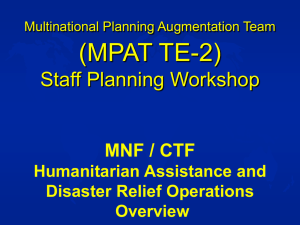
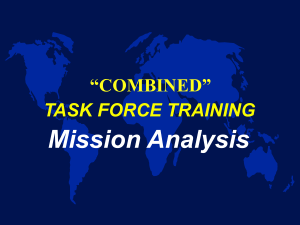
![Cherish the Family [PPT] - National Abandoned Infants Assistance](http://s2.studylib.net/store/data/005476619_1-44768cf7ece3219205cc51da81672e3a-300x300.png)
